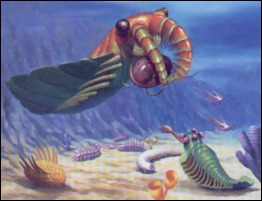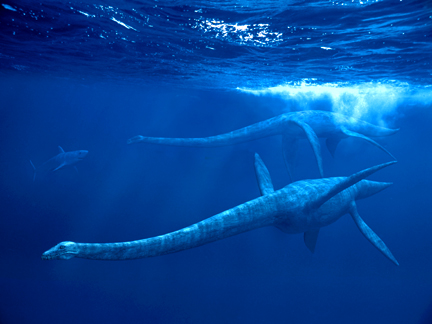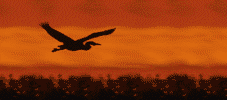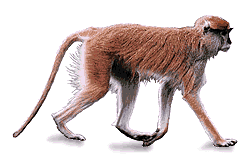
Evolution - Life on Earth
 |
When
one first starts to study biology one is often not aware of the fact that
the world has not always been the way it is at the moment. To study the
changes in life forms one often have to turn to what is referred to as
"deep time" or geological time. This time scale looks at changes that occur
over millions and millions of years. As an example we can turn to the today
highly successful group referred to as the flowering plants. If you went
back in time to a period about 140 million years ago you would find a world
lacking in the plants that now dominate the terrestrial world. At that
time you would find no flowers, no grasses and none of the familiar trees
such as oak or maple. Most species that have evolved on our planet are
extinct. After finishing this section of the course you will have
an appreciation and an overview of how some of the major groups of organisms
evolved on the planet over the last four billion years. Focus on your ability
to outline the significance of major evolutionary events as well as when
they occurred in Earth's history. |
-
Make a timeline which indicates
the major events of the history of life on our planet. Outline major events
that occurred in each geological period.
-
When did the Earth form? The Solar
system? Our universe?
-
Describe the conditions on the
early earth about 4.5 billion years ago.
-
Explain the process of chemical
evolution. How does it differ from the concept of biological evolution?
-
When does the first life appear
in the fossil record? What kind of organism were the first life forms on
Earth?
-
What kind of life form dominated
in the seas of the early earth for almost two billion years? Was there
any life on land during this time?
-
Why was the evolution of photosynthesis
so important?
-
How was the formation of ozone
in the upper atmosphere important for the evolutionary events that followed?
-
When did the first animals appear
in the fossil record? What kind of animals were they?
-
What is the importance of the
Burgess shale for our understanding of animal evolution?
-
Discuss the reasons for why first
plants, and later animals, evolved on land (both terrestrial plants and
animals descended from marine ancestors)?
-
What is thought to be the cause
of the Cretaceous mass extinction which wiped out the lineage of dinosaurs?
-
Mammals went through a major adaptive
radiation beginning about 65 million years ago. The fossil record indicates
a mammalian origin of about 225 million years. What took them so long?
-
Briefly describe the evolution
of primates with a focus on the hominids.
-
What kind of perspective did you
gain from the "calendar year" analogy?
Lecture
Outline/Notes:
NOTE: When you approach
this section of the course you should focus on the timeline approach from
lecture, i.e. you should know the major sequence of events as described
by The
Geological Time Scale . This timeline
link could also be somewhat helpful in terms of aiding your memory.
Below I have added additional "meat" to this timeline in aspects mainly
related to the evolution of the vertebrates. I have done so to help you
gain perspective for what will come later on this semester. I will not
test you on those aspects on the first exam. Remember, focus on understanding
the timeline/geological timeline as you approach this section for the first
exam. It is also quite worthwhile to do the
web activity below as well as to take a closer peek at the Cambrian
section.
Time Line: As
you study this section of the class you should produce a timeline that
shows the major events in the history of life on our planet. The lecture,
your notes as well as this page will help you to do so. Please complete
the web activity "Deep Time". It is an outstanding resource. 
Plate Tectonics:
Try to notice the changes that occur in terms of the geography of the planet
due to plate tectonics. Where were the modern continents located at different
times in the history of the planet? Did their movement affect the evolution
of different species? How? |
|
Origins: Brief
perspective from an astronomer's point of view
The Big Bang Theory (~13 billions
of years ago)
Formation of the solar system
about 6 billion years ago.
Formation of the Earth about
4.7
billion years ago (bya)
Early Earth:
extreme conditions, high volcanic activity, earthquakes; extremely hot;
cooling process; water condensed; seas formed.
Atmospheric Composition:
water vapor, hydrogen, nitrogen, methane, carbon dioxide. High electrical
activity in the atmosphere (lightning).
Chemical Evolution:
Miller�s experiment in the 1950�s: simulated early conditions on Earth
and generated simple organic molecules such as sugars, amino acids and
nucleotides from inorganic components. This process is referred to as chemical
evolution. The Miller experiment indicates that these conditions could
have led to the formation of the molecules of life (proteins; DNA; carbohydrates,
etc.).
Origin of Life:
Other experiments have led to the formation of nucleic acids as well as
primitive cell membranes. It is thought that the first cell (or cells)
evolved under these extreme conditions on the early earth. Nobody has yet
produced a self-replicating cell under laboratory conditions.
It appears as if all living
organisms that exist today are descendants of these first cells that evolved
about 3.8 billion years ago. One of the strongest pieces of evidence for
our common ancestry is that virtually all cells share the genetic code.
The cellular machinery is extremely similar in all cells. E.g. an amoeba
(which is unicellular) or a cell from an earthworm or a cell from a beetle
or a cell from a zebra all share similar cellular and metabolic processes
in terms of how their cells function. Those cells express their DNA in
a very similar fashion. |
|
First Life forms:
prokaryotic cells, bacteria, about 3.5-3.8 bya as shown by microscopic
fossil in strata from that time period. Early cells lived on pre-formed
organic molecules in the oceans. They were heterotrophs. Bacterial species
were the only life forms in the oceans of the planet for the next two billion
years. No life existed on land.
Photosynthesis:
the first photosynthetic bacteria appeared about 2.5 - 2.8 bya. These lifeforms
could use light energy to chemically combine carbon dioxide molecules from
the atmosphere into simple sugars. Thereby these bacteria became largely
independent from the need to access organic molecules from the environment
around them as a food source. The process of photosynthesis became the
basis for nearly all ecosystems across our planet (the producers). Some
of these bacteria started to produce oxygen as a byproduct of photosynthesis.
Oxygen slowly started to accumulate in the atmosphere (0% to today's 20.9%).
The level of oxygen in the atmosphere reached today's level more than 500
million years ago during the Cambrian period. Oxygen became a very important
component (actually as a final electron acceptor) in the metabolic pathway
referred to as cellular respiration. The presence of oxygen also led to
the formation of ozone (O3) that blocks radiation from the sun in the upper
atmosphere. The ozone layer later made life
possible on land by shielding the radiation (ultraviolet light) for land
organisms. The photosynthetic bacteria were of course also the origin of
the photosynthetic process later used by the land plants.
First Eukaryotic Cells:
appeared about 1.8 bya. These cells are traditionally characterized by
their larger size and the presence of organelles such as a nucleus, mitochondria
and chloroplasts. The last two organelles have a bacterial origin (endosymbiotic
theory).
First Animals:
Fossils from about 600 -700 mya demonstrate the first presence of animals.
The Cambrian period (570-510 mya) is known for the rapid evolutionary "explosion"
of different animal body plans. The Burgess
Shale in Canada is one of the locations that harbor an amazing array
of fossils. These early animals were soft-bodied invertebrates (animals
without a backbone). The fossil record indicates a great variety of different
body plans. A very large adaptive radiation of marine organisms occurred
about 500 mya. The evolution of fast-moving predators led to the evolution
of animals that protected themselves with shells or by burrowing into soft
sediment.
Today the greatest diversity
of animals (in terms of major types of animals (phyla) - not the
number of species) is found in the oceans indicating the evolutionary origin
of the animal kingdom.
Interactions (such as competition
and predation) between different animals species as well as their environment
led to a variety of different body plans and adaptations. All animals that
exist today can trace their ancestral origins to the animal species that
evolved during the Cambrian period. |

|
First Vertebrates
The earliest vertebrates (animals with a backbone) possibly evolved at
the end of the Cambrian period (570-505 mya). These animals were jawless
fishes. Somewhat later some groups of fishes evolved a jaw (the Silurian
period 439-409 mya). The evolution of the jaw led to a major adaptive radiation
among the fishes. Why do you think that the jaw was (and still is) such
a useful characteristic? Do all vertebrates have a jaw? Why or why not?
The fishes are still the most diverse group of the vertebrates and can
be found in any marine or freshwater habitat on the planet. There are many
unusual fish species that are interesting to study from an evolutionary
perspective. Interestingly the fresh water environment has much higher
diversity of fish species that the marine environment. Why could that be?
First Land Plants:
The first plants colonized land during the Ordovician period (510-440 mya).
These early plant communities were mostly low profile moss-like organisms
with algal ancestors. Advantages on land: plenty of light, no plant eating
animals. Disadvantages: desiccation, how to get nutrients and water, overheating,
reproduction. Remember our discussion on how evolution and natural
selection led to organisms better and better adapted to a life on land.
The better adapted (initially) the more likely to escape animals feeding
on you. Ferns (380 mya), Gymnosperms [i.e. seed plants such as conifers
and relatives] (360 mya) and Angiosperms [flowering plants] (130 mya) evolved.
Each group was distinctly better adapted to the harsh life on land as well
as the lack of water. There is an overall trend in the evolution of plants
that continuously makes it possible to survive with less water. The plant
kingdom is very diverse so today one can see an amazing array of adaptations
to all the different biomes on our planet. Some plants survive in the harshest
desert while others are floating plants found in fresh water habitats.
First Land Invertebrates:
~400 mya (Silurian period 440-409 mya). These species followed the plants
(=food). The better adapted to land conditions the more food is available
and the reproductive success increases. These first land animals belonged
to the Arthropods (specifically these were millipedes, centipedes
and scorpions). The insects somewhat later (Devonian period 409-354 mya)
diversified into an enormous array of different species and today dominate
the biodiversity on the planet. Today 25% of all animal species are beetles.
About 75% of all animal species are insects. Their success in terms of
their biodiversity in the modern world is tremendous.
| First Land Vertebrates
(The Tetrapods): These animals can trace their ancestry to fishes.
Some of the modern (extant) fish species show traits that must have been
important in the ancestor to the amphibians: the lung fish with
a lung able to breathe air, and the Coelecanth
with a fleshy fin containing bones similar in arrangement to limbs in land
vertebrates. The coelecanth was thought to be extinct so its
discovery was a thrill to many biologists. The combination of these
two traits in one group of fishes led to the evolution of the first Amphibians.
Acanthostega
is an example of these early amphibians. |
|
Amphibians: Moist
glandular skin, lay eggs in water (cannot dry out); life cycle (egg - tadpole
- adult). Some early amphibians became very large. (today: frogs, salamanders,
caecilians)
| Reptiles: amphibian
ancestors; better adapted to a life on land; the major problems to solve
are desiccation and the ability to reproduce without water. Reptiles evolved
a scaly keratinized skin; the amniotic egg (egg w/ shell and nutrients
for the embryo that could be laid on land; the embryo is surrounded by
a membrane called the amnion); internal fertilization (i.e. copulation
to protect the gametes); and efficient kidneys to conserve water. The dinosaurs
was a group of reptiles that became very dominant for about 200 my (~250
mya to 65 mya). The dinosaurs went extinct in a major mass extinction 65
mya (the Cretaceous extinction) caused by a meteor impact with the
Earth. Today: alligators, crocodiles, lizards, snakes, turtles and tortoises
are living representatives of the taxon. |
 |
 |
Birds: a group
derived from the reptiles (specifically the dinosaurs). Many biologists
consider these organisms as being living descendants of the dinosaurs.
Main characteristic is the feather made of keratin. Serves as a device
for flying (lift) as well as insulation. Birds are endotherms, i.e. they
maintain body temperature with their metabolism. Birds are highly adapted
to a life in the air (even though some birds are flightless). The ancestry
of birds relative to the reptiles is demonstrated by the presence of the
amniotic egg and scaly legs. Intermediate fossils have been found (such
as Archaeopteryx - a "reptile" fossil with feathers). |
| Mammals: another
group with an origin from the reptiles (more specifically the therapsids).
Characterized by fur (for insulation since mammals are endotherms just
like birds) as well as mammary glands to feed the young. Mammary glands
are modified sweat glands. Mammals appeared about 225 mya in the
fossil record. Early mammals were very small (like a shrew), and are thought
to have been nocturnal tree-living animals. The group did not expand until
the dinosaurs went extinct 65 mya. The mammals went through a major adaptive
radiation leading to the mammals we see on our planet today. Of special
interest are the primates with their origin from tree living mammals
about 40 mya. |
 |
|
|
Human Origins:
Fossils from eastern Africa from about 3.5 mya show primates with very
human like features - Australopithecus - the
famous �Lucy� fossil and other members of her kind. We are going to
take
a much closer look at the
human ancestors later. Humans (Homo sapiens) as
we look today did not appear until about 200,000 years ago.. Please
complete the web activity "Human Origins".
Our recorded history
only covers a time span of 10,000 years - an extremely small fraction of
the evolutionary time covered in this lecture. The last minute of our imaginary
calendar year! |
Links






